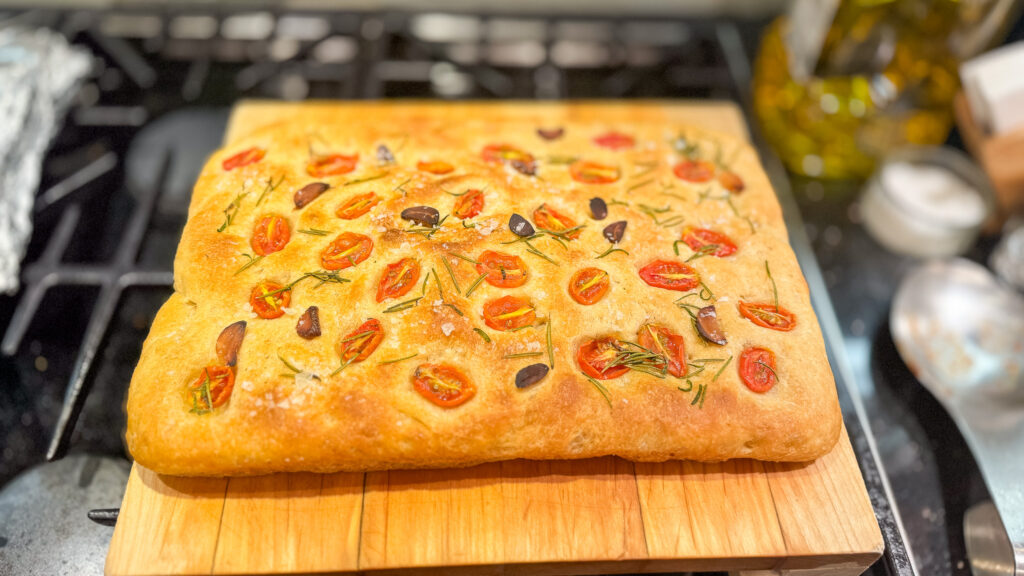I first tasted focaccia back in the 1990s, while eating out for lunch with some of my co-workers. We had gone to a restaurant called Fresh Choice (now defunct) near the office, which was known for their all-you-can-eat soups, salads, and breads. I saw the focaccia and was intrigued by it, so I got some during my first visit. I immediately fell in love with it.
I encountered focaccia in a few other restaurants over time. And of course, my trips to Italy were always filled with various focaccia-based sandwiches (especially when they are filled with local salumi, cheeses, sun-dried tomatoes, olives, etc.)

I came up with this recipe after doing some research (once I had my sourdough starter going during the pandemic) and a bit of trial and error with the ratios. The texture of this focaccia is very similar to the ones I had first at Fresh Choice.
Ingredients:
- 200 g ripe (fed) sourdough starter
- 150 g lukewarm water (see Additional Notes)
- 50 g olive oil, plus extra for the pan and the top of the focaccia
- 25 g honey
- 350 g bread flour or all-purpose flour
- 10 g salt
- 15 g gluten (if using all-purpose flour)
Focaccia toppings:
Focaccia toppings vary – it’s up to you to decide. You can leave your focaccia plain, with just olive oil and sea salt as toppings (see the step before baking).
Here is a list of my favorite toppings:
- sun-dried tomatoes
- sliced black olives
- thinly sliced garlic
- dried rosemary leaves
- pesto (only add it after taking it out of the oven)
- salami
- Mortadella
- grated cheddar (or an other cheeses)
Method
Mix sourdough starter with water in a bowl. Then add the honey, olive oil, bread flour, and salt, and mix thoroughly until all of the ingredients are incorporated (a Danish whisk is ideal and makes mixing easier).
Let the dough fermentolyse for about an hour. After an hour, check the temperature, making sure it’s close to 78°F. If you haven’t reached the desired temperature, continue letting the dough fermentolyse until the temperature is reached.
Perform a series of 4 stretches and folds every 30 minutes to create gluten structures. You’ll notice the dough get smoother over time, and that you’ll have a harder time stretching the dough out as you do the stretch and folds. Keep at it!
After the 4th stretch and fold, let the dough rest for about an hour. In the meantime, grease a 9” x 13” baking pan by adding about 1 to 2 tablespoons of olive oil.
After about an hour, check to see if the temp of the dough is around 78°F. Let the dough rest some more (another 15 to 30 minutes) and check the temperature again. Repeat as many times as necessary until you hit the 78°F.
When the dough is ready (at 78°F), dump it over the greased pan. Using your hands and fingers, spread the dough out and flatten it. Then fold into thirds, like a letter. Turn the dough 90° so that the long edge of the folded dough matches the long edge of the pan. Repeat stretching it out and folding it into thirds a second time.
After the second letter fold, stretch the dough out as far as you can. You will find the dough snapping back on itself. Let it rest for 10 minutes, and stretch the dough out. Repeat as necessary, bouncing back between stretching and the 10-minute rest, until you have the dough flush to the walls of the pan.
Once you have the dough stretched out in the pan, create dimples on the dough with your fingers. Then add your focaccia toppings, pressing down on them so they stick on the dough.
Let the dough rise for about 2 to 3 hours. It should more than double and reach almost the top of the pan.
Preheat your oven to 385° F. While the oven is preheating, pour about 2 to 3 tablespoons of high-quality virgin olive oil on top of your focaccia. Then sprinkle a little of finishing salt flakes on top.
Bake for about 30 to 40 minutes. Make sure to check at the 10 minute or so mark. If you find your toppings starting to burn, cover the focaccia with some foil and let it continue to bake.
Additional Notes:
Always check and target dough temperature to hit 78°F. I learned this from the Sourdough Geeks group that I belong to on Facebook. This temperature lets you know that your dough is properly proofed and you are ready to go to the next step.
Using tap water is fine, but I warm mine up from anywhere between 85° to 95°F. This temperature makes your sourdough starter (or yeast) more active.
If your sourdough is unfed, expect to wait more for your dough to react and rise (24 hours or more, in some cases).
Leave a Reply